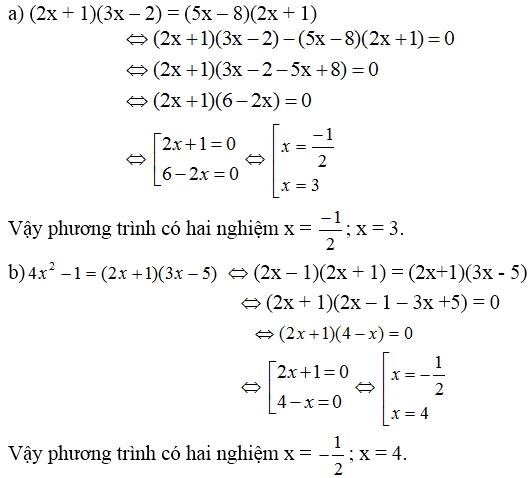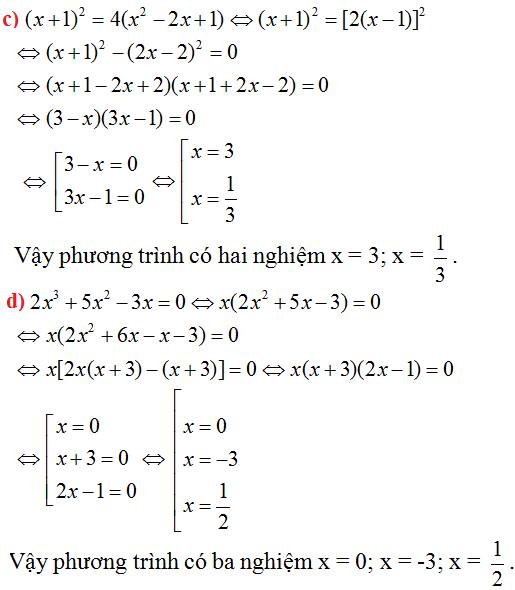
Hãy nhập câu hỏi của bạn vào đây, nếu là tài khoản VIP, bạn sẽ được ưu tiên trả lời.


a) 7x - 35 = 0
<=> 7x = 0 + 35
<=> 7x = 35
<=> x = 5
b) 4x - x - 18 = 0
<=> 3x - 18 = 0
<=> 3x = 0 + 18
<=> 3x = 18
<=> x = 5
c) x - 6 = 8 - x
<=> x - 6 + x = 8
<=> 2x - 6 = 8
<=> 2x = 8 + 6
<=> 2x = 14
<=> x = 7
d) 48 - 5x = 39 - 2x
<=> 48 - 5x + 2x = 39
<=> 48 - 3x = 39
<=> -3x = 39 - 48
<=> -3x = -9
<=> x = 3

Cái bài đầu giải BPT bn ghi cái dj ak ,mik cx k hỉu nữa
V mik giải bài 2 nghen, sửa lại đề bài đầu rồi mik giải cho
\(3x-3=|2x+1|\)
Điều kiện: \(3x-3\ge0\Leftrightarrow3x\ge3\Leftrightarrow x\ge1\)
\(\Leftrightarrow\orbr{\begin{cases}2x+1=3x-3\\2x+1=-3x+3\end{cases}}\)
\(\Leftrightarrow\orbr{\begin{cases}2x-3x=-1-3\\2x+3x=-1+3\end{cases}}\)
\(\Leftrightarrow\orbr{\begin{cases}-x=-3\\5x=2\end{cases}\Leftrightarrow\orbr{\begin{cases}x=3\left(n\right)\\x=\frac{2}{5}\left(l\right)\end{cases}}}\)
Vậy S={3}
Cài đề câu b ,bn xem lại nhé!
\(\frac{2x-3}{35}+\frac{x\left(x-2\right)}{7}>\frac{x^2}{7}-\frac{2x-3}{5}\)
\(\Leftrightarrow\frac{2x-3}{35}+\frac{5x\left(x-2\right)}{35}-\frac{5x^2}{35}+\frac{7\left(2x-3\right)}{35}>0\)
\(\Leftrightarrow2x-3+5x\left(x-2\right)-5x^2+7\left(2x-3\right)>0\)
\(\Leftrightarrow2x-3+5x^2-10x-5x^2+14x-21>0\)
\(\Leftrightarrow6x-24>0\)
\(\Leftrightarrow x>4\)
VẬY TẬP NGHIỆM CỦA BẤT PHƯƠNG TRÌNH LÀ : S = { \(x\text{\x}>4\)}
\(\frac{6x+1}{18}+\frac{x+3}{12}\le\frac{5x+3}{6}+\frac{12-5x}{9}\)
\(\Leftrightarrow\frac{6\left(6x+1\right)}{108}+\frac{9\left(x+3\right)}{108}\le\frac{18\left(5x+3\right)}{108}+\frac{12\left(12-5x\right)}{108}\)
\(\Leftrightarrow36x+6+9x+27\le90x+54+144-60x\)
\(\Leftrightarrow36x+6+9x+27-90x-54-144+60x\le0\)
\(\Leftrightarrow15x-165\le0\)
\(\Leftrightarrow x\le11\)
VẬY TẬP NGHIỆM CỦA BẤT PHƯƠNG trình ..........
tk mk nka !!! chúc bạn học tốt !!!

Bài làm
j) \(\frac{x+5}{x-5}-\frac{x-5}{x+5}=\frac{20}{x^2-25}\) ĐKXĐ: \(x\ne\pm5\)
\(\Leftrightarrow\frac{\left(x+5\right)^2}{x^2-25}-\frac{\left(x-5\right)^2}{x^2-25}=\frac{20}{x^2-25}\)
\(\Rightarrow x^2+10x+25-x^2+10x-25=20\)
\(\Leftrightarrow20x=20\)
\(\Leftrightarrow x=1\)
Vậy x = 1 là nghiệm phương trình.
k) \(\frac{3}{x-4}+\frac{5x-2}{x^2-16}=\frac{4}{x+4}\)
\(\Leftrightarrow\frac{3\left(x+4\right)}{x^2-16}+\frac{5x-2}{x^2-16}=\frac{4\left(x-4\right)}{x^2-16}\)
\(\Rightarrow3x+12+5x-2=4x-16\)
\(\Leftrightarrow4x=-26\)
<=> \(x=-\frac{13}{2}\)
Vậy x = -13/2 là nghiệm phương trình.
l) \(\frac{2x-1}{3}-\frac{5x+2}{4}=2x\)
\(\Leftrightarrow4x-4-15x-6=24x\)
\(\Leftrightarrow-35x=10\)
\(\Leftrightarrow x=-\frac{2}{7}\)
Vậy x = -2/7 là nghiệm phương trình.
Bài làm
2 - x = 3x + 1
<=> - x - 3x = -2 + 1
<=> -4x = -1
<=> x = 1/4
Vậy x = 1/4 là nghiệm phương trình.
4x + 7( x - 2 ) = -9x + 5
<=> 4x + 7x - 14 = -9x + 5
<=> 4x + 7x + 9x = 14 + 5
<=> 20x = 19
<=> x = 19/20
Vậy x = 19/20 là nghiệm phương trình.
5x - 2( 3x - 5 ) = 7x + 11
<=> 5x - 6x + 10 = 7x + 11
<=> 5x - 6x - 7x = 11 - 10
<=> -8x = -21
<=> x = 21/8
Vậy x = 21/8 là nghiệm phương trình.
( 5x + 2 )( x - 7 ) = 0
<=> \(\left[{}\begin{matrix}5x+2=0\\x-7=0\end{matrix}\right.\Leftrightarrow\left[{}\begin{matrix}x=-\frac{2}{5}\\x=7\end{matrix}\right.\)
Vậy tập nghiệm phương trình S = { -2/5; 7 }
2x( x - 5 ) + 3( x - 5 ) = 0
<=> ( 2x + 3 )( x - 5 ) = 0
<=> \(\left[{}\begin{matrix}2x+3=0\\x-5=0\end{matrix}\right.\Leftrightarrow\left[{}\begin{matrix}x=-\frac{3}{2}\\x=5\end{matrix}\right.\)
Vậy tập nghiệm phương trìh S = { -3/2; 5 }
\(\frac{5x-3}{6}=\frac{-2x+5}{9}\)
\(\Rightarrow6\left(-2x+5\right)=9\left(5x-3\right)\)
\(\Leftrightarrow-12x+30=45x-27\)
\(\Leftrightarrow-57x=-57\)
\(\Leftrightarrow x=1\)
Vậy x = 1 là nghiệm phương trình.
\(\frac{x}{3}-\frac{2x+1}{2}=\frac{5x}{6}\)
\(\Leftrightarrow2x-3\left(2x+1\right)=5x\)
\(\Leftrightarrow2x-6x-3=5x\)
\(\Leftrightarrow-9x=3\)
\(\Leftrightarrow x=-\frac{1}{3}\)
Vậy x = -1/3 là nghiệm phương trình.
\(\frac{x}{3}-\frac{2x+1}{2}=\frac{x}{6}-x\)
\(\Leftrightarrow2x-3\left(2x+1\right)=x-6x\)
\(\Leftrightarrow2x-6x-3=x-6x\)
\(\Leftrightarrow2x=3\)
\(\Leftrightarrow x=\frac{3}{2}\)
Vậy x = 3/2 là nghiệm phương trình.
\(\frac{3}{x+1}=\frac{5}{2x+2}\) ĐKXĐ: x khác 1
<=> \(\frac{6}{2x+2}=\frac{5}{2x+2}\)( vô lí )
Vậy phương trình trên vô nghiệm.
# Học tốt #

a)(2x+1)(3x-2)=(5x-8)(2x+1)
⇔(2x+1)(3x-2)-(5x-8)(2x+1)=0
⇔(2x+1)(3x-2-5x+8)=0
⇔(2x+1)(-2x+6)=0
⇔2x+1=0 hoặc -2x+6=0
1.2x+1=0⇔2x=-1⇔x=-1/2
2.-2x+6=0⇔-2x=-6⇔x=3
phương trình có 2 nghiệm x=-1/2 và x=3

(x2 + x + 1)(6 - 2x) = 0
<=> 6 - 2x = 0 (do x2 + x + 1 > 0)
<=> 2x = 6
<=> x = 3
Vậy S = {3}
(8x - 4)(x2 + 2x + 2) = 0
<=> 8x - 4 = 0 (vì x2 + 2x + 2 > 0)
<=> 8x = 4
<=> x = 1/2
Vậy S = {1/2}
x3 - 7x + 6 = 0
<=> x3 - x - 6x + 6 = 0
<=> x(x2 - 1) - 6(x - 1) = 0
<=> x(x - 1)(x + 1) - 6(x - 1) = 0
<=> (x2 + x - 6)(x - 1) = 0
<=> (x2 + 3x - 2x - 6)(x - 1) = 0
<=> (x + 3)(x - 2)(x - 1) = 0
<=> x + 3 = 0
hoặc x - 2 = 0
hoặc x - 1 = 0
<=> x = -3
hoặc x = 2
hoặc x = 1
Vậy S = {-3; 1; 2}
x5 - 5x3 + 4x = 0
<=> x(x4 - 5x2 + 4) = 0
<=> x(x4 - x2 - 4x2 + 4) = 0
<=> x[x2(x2 - 1) - 4(x2 - 1)] = 0
<=> x(x - 2)(x + 2)(x - 1)(x + 1) = 0
<=> x = 0 hoặc x - 2 = 0 hoặc x + 2 = 0 hoặc x - 1 = 0 hoặc x + 1 = 0
<=> x = 0 hoặc x = 2 hoặc x = -2 hoặc x = 1 hoặc x = -1
Vậy S = {-2; -1; 0; 1; 2}
+ Ta có: \(\left(x^2+x+1\right).\left(6-2x\right)=0\)
- Ta lại có: \(x^2+x+1=\left(x^2+x+\frac{1}{4}\right)+\frac{3}{4}=\left(x+\frac{1}{2}\right)^2+\frac{3}{4}\ge\frac{3}{4}>0\forall x\)
- Vì \(x^2+x+1>0\forall x\)mà \(\left(x^2+x+1\right).\left(6-2x\right)=0\)
\(\Rightarrow6-2x=0\Leftrightarrow-2x=-6\Leftrightarrow x=3\left(TM\right)\)
Vậy \(S=\left\{3\right\}\)
+ Ta có: \(\left(8x-4\right).\left(x^2+2x+2\right)=0\)
- Ta lại có: \(x^2+2x+2=\left(x^2+2x+1\right)+1=\left(x+1\right)^2+1\ge1>0\forall x\)
- Vì \(x^2+2x+2>0\forall x\)mà \(\left(8x-4\right).\left(x^2+2x+2\right)=0\)
\(\Rightarrow8x-4=0\Leftrightarrow8x=4\Leftrightarrow x=\frac{1}{2}\left(TM\right)\)
Vậy \(S=\left\{\frac{1}{2}\right\}\)
+ Ta có: \(x^3-7x+6=0\)
\(\Leftrightarrow\left(x^3-x^2\right)+\left(x^2-x\right)+\left(6x-6\right)=0\)
\(\Leftrightarrow\left(x-1\right).\left(x^2+x-6\right)=0\)
\(\Leftrightarrow\left(x-1\right).\left[\left(x^2-2x\right)+\left(3x-6\right)\right]=0\)
\(\Leftrightarrow\left(x-1\right).\left(x-2\right).\left(x+3\right)=0\)
Vậy \(S=\left\{-3;1;2\right\}\)
+ Ta có: \(x^5-5x^3+4x=0\)
\(\Leftrightarrow x.\left[\left(x^4-x^2\right)-\left(4x^2-4\right)\right]=0\)
\(\Leftrightarrow x.\left[x^2.\left(x^2-1\right)-4.\left(x^2-1\right)\right]=0\)
\(\Leftrightarrow x.\left(x^2-1\right).\left(x^2-4\right)=0\)
\(\Leftrightarrow x=0\left(TM\right)\)
hoặc \(x^2-1=0\Leftrightarrow x^2=1\Leftrightarrow x=\pm1\left(TM\right)\)
hoặc \(x^2-4=0\Leftrightarrow x^2=4\Leftrightarrow x=\pm2\left(TM\right)\)
Vậy \(S=\left\{-2;-1;0;1;2\right\}\)
!!@@# ^_^ Chúc bạn hok tốt ^_^#@@!!

a,\(\frac{2x+5}{3}-2=\frac{3x-7}{5}\)
\(\Rightarrow5\left(2x+5\right)-30=3\left(3x-7\right)\)
\(\Leftrightarrow10x+25-30=9x-27\)
\(\Leftrightarrow x=-22\)
vậy....................
\(b,\frac{x}{6}+x=\frac{2x+1}{2}\)
\(\Rightarrow2x+12x=6\left(2x+1\right)\)
\(\Leftrightarrow14x=12x+6\)
\(\Leftrightarrow2x=6\)
\(\Leftrightarrow x=3\)
vậy.....................
c,\(\frac{x}{4}-\frac{2x-1}{3}=-\frac{5x}{12}\)
\(\Rightarrow3x-4\left(2x-1\right)=-5x\)
\(\Leftrightarrow3x-8x+4=-5x\)
\(\Leftrightarrow0x=-4\left(PTVN\right)\)
VẬY................
P/s : bạn chú ý \(\Rightarrow\)với \(\Leftrightarrow\)nha

Bài làm
~ Bạn Thủy bên dưới có vẻ bị Lag mạnh, bài dễ như này mà cũng dùng denta với đen tiếc. Đéo biết làm thì đừng làm chứ đéo phải làm cái kiểu mà lớp 8 chưa học nhé bạn >.<, câu c dòng thứ hai với dòng thứ 3 không phải là thừa sao? đã vậy câu c làm sai đề nữa, bên trên là 1 - 5x. bên dưới là 1 + 5x . câu cuối cũng sai hằng đẳng thức, phải là +16x chứ hông phỉa -16x.~
a) 2x + 5 = 20 - 3x
<=> 2x + 3x = 20 + 5
<=> 5x = 25
<=> x = 5
Vậy x = 5 là nghiệm phương trình.
b) 4x2 + 5x = 0
<=> x( 4x + 5 ) = 0
<=> \(\orbr{\begin{cases}x=0\\4x+5=0\end{cases}\Leftrightarrow\orbr{\begin{cases}x=0\\x=-\frac{5}{4}\end{cases}}}\)
Vậy S = { 0; -5/4 }
c) \(\left(x-2\right)^2=1-5x\)
<=> \(x^2-4x+4=1-5x\)
<=> x2 - 4x + 5x - 1 + 4 = 0
<=> x2 + x + 3 = 0
<=> \(x^2+x.2.\frac{1}{2}+\frac{1}{4}+\frac{11}{4}=0\)
<=> \(\left(x^2+x+\frac{1}{4}\right)=-\frac{11}{4}\)
\(\Leftrightarrow\left(x+\frac{1}{2}\right)^2=-\frac{11}{4}\)( vô lí )
Vậy phương trình vô nghiệm.
d) x2 + 5x + 6 = 0
<=> x2 + 2x + 3x + 6 = 0
<=> x( x + 2 ) + 3( x + 2 ) = 0
<=> ( x + 3 )( x + 2 ) = 0
<=> \(\orbr{\begin{cases}x+3=0\\x+2=0\end{cases}\Leftrightarrow\orbr{\begin{cases}x=-3\\x=-2\end{cases}}}\)
Vậy tập nghiệm phương trình S = { -3; -2 }
e) x4 - 5x2 + 4 = 0
<=> x4 - x2 - 4x2 + 4 = 0
<=> x2( x2 - 1 ) - 4( x2 - 1 ) = 0
<=> ( x2 - 1 )( x2 - 4 ) = 0
<=> ( x - 1 )( x + 1 )( x - 2 )( x + 2 ) = 0
<=> \(\orbr{\begin{cases}x-1=0\\x+1=0\end{cases}\Leftrightarrow\orbr{\begin{cases}x=1\\x=-1\end{cases}}}\)
\(\orbr{\begin{cases}x-2=0\\x+2=0\end{cases}\Leftrightarrow\orbr{\begin{cases}x=2\\x=-2\end{cases}}}\)
Vậy tập nghiệm phương trình S = { 1; -1; 2; -2 }
f) 5( x2 - 3x ) = ( 4x + 2 )2 + 1
<=> 5x2 - 15x = 16x2 + 16x + 4 + 1
<=> 5x2 - 16x2 - 15x - 16x - 4 - 1 = 0
<=> -11x2 - 31x - 5 = 0
<=> -( 11x2 + 31x + 5 ) = 0
Ta có:( 11x2 + 31x + 5 ) > 0 V x
=> -( 11x2 + 31x + 5 ) < 0 V x
=> -( 11x2 + 31x + 5 ) = 0 ( vô lí )
Vậy phương trình vô nghiệm.
a, \(2x+5=20-3x\)
\(2x+5-20+3x=0\)
\(5x-15=0\Leftrightarrow5x=15\Leftrightarrow x=3\)
b, \(4x^2+5x=0\)
\(x\left(4x+5\right)=0\)
\(x=0\)
\(4x+5=0\Leftrightarrow4x=-5\Leftrightarrow x=-\frac{5}{4}\)
c, \(\left(x-2\right)^2=1-5x\)
\(\left(x-2\right)=\pm\sqrt{1-5x}\)
\(x-2=\sqrt{1+5x}\)
\(x^2-4x+4=1+5x\)
\(x^2-4x+4-1-5x=0\)
\(x^2-9x+3=0\)
\(\Delta=b^2-4ac=\left(-9\right)^2-4.3.1=81-12=69>0\)
Nên pt có 2 nghiệm phân biệt
\(x_1=\frac{9-\sqrt{69}}{2.1}=\frac{9-\sqrt{69}}{2}\)
\(x_2=\frac{9+\sqrt{69}}{2.1}=\frac{9+\sqrt{69}}{2}\)

a, Xét x=0 không phải nghiệm pt chia 2 vế cho x2 , đặt t= x+1/x từ đó suy ra phương trình ẩn t, giải ra ta được các phương trình ẩn x rồi ra x.
b, Tách đa thức thành tích của đơn thức (x+1) và 1 đa thức bậc 4 rồi làm như câu a,.
\(2x^4+3x^3-x^2+3x+2=0\)
\(\Leftrightarrow2x^4+4x^3-x^3-2x^2+x^2+2x+x+2=0\)
\(\Leftrightarrow2x^3.\left(x+2\right)-x^2.\left(x+2\right)+x.\left(x+2\right)+\left(x+2\right)=0\)
\(\Leftrightarrow\left(x+2\right).\left(2x^3-x^2+x+1\right)=0\)
\(\Leftrightarrow\left(x+2\right).\left(2x^3+x^2-2x^2-x+2x+1\right)=0\)
\(\Leftrightarrow\left(x+2\right).\left(2x+1\right).\left(x^2-x+1\right)=0\)
\(\Leftrightarrow\orbr{\begin{cases}x+2=0\\2x+1=0\end{cases}\Rightarrow\orbr{\begin{cases}x=-2\\x=-\frac{1}{2}\end{cases}}}\)
\(\text{Vì }x^2-x+1=x^2-x+\frac{1}{4}+\frac{3}{4}=\left(x-\frac{1}{2}\right)^2+\frac{3}{4}\ge\frac{3}{4}\)
Vậy phương trình có nghiệm \(S=\left\{-2,-\frac{1}{2}\right\}\)


(2x + 7)(x – 5)(5x + 1) = 0
⇔ 2x + 7 = 0 hoặc x – 5 = 0 hoặc 5x + 1 = 0
+ 2x + 7 = 0 ⇔ 2x = -7 ⇔
+ x – 5 = 0 ⇔ x = 5.
+ 5x + 1 = 0 ⇔ 5x = -1 ⇔
Vậy phương trình có tập nghiệm